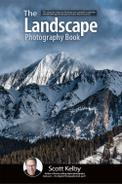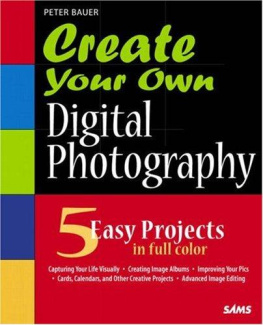About the Author
Dan Bailey is a professional outdoor, adventure, and travel photographer based in Anchorage, Alaska. His work has been published by clients such as Fujifilm, Outside magazine, Climbing , Rock & Ice , Coleman, Discovery Channel Publications, National Geographic Adventure, The North Face, Marmot, and Patagonia. He has written articles for Digital Photo Pro , Photo.net , and Outdoor Photographer . Visit his website at: danbaileyphoto.com.
FALCON GUIDES
An imprint of Rowman & Littlefield
Falcon, FalconGuides, and Outfit Your Mind are registered trademarks of Rowman & Littlefield.
Distributed by NATIONAL BOOK NETWORK
Copyright 2015 by Rowman & Littlefield
All rights reserved. No part of this book may be reproduced in any form or by any electronic or mechanical means, including information storage and retrieval systems, without written permission from the publisher, except by a reviewer who may quote passages in a review.
British Library Cataloguing in Publication Information Available
Library of Congress Cataloging-in-Publication Data is available on file.
ISBN 978-1-4930-0974-9 (paperback)
ISBN 978-1-4930-1977-9 (ebook)
 The paper used in this publication meets the minimum requirements of American National Standard for Information SciencesPermanence of Paper for Printed Library Materials, ANSI/NISO Z39.48-1992.
The paper used in this publication meets the minimum requirements of American National Standard for Information SciencesPermanence of Paper for Printed Library Materials, ANSI/NISO Z39.48-1992.
The author and Globe Pequot assume no liability for accidents happening to, or injuries sustained by, readers who engage in the activities described in this book.

Chapter One
Introduction: Photography and Adventure
You love to explore with your camera as you travel through the outdoors, always eager to see whats around the next bend. You take special notice when the light turns orange, then pink; when the shadows stretch and you see your fellow adventurers pass by a spectacular background. For you, the photography is often as fulfilling as the adventure itself.
No matter what outdoor activities you like, adventure and photography offer boundless opportunity for creative exploration. Once they get in your blood, these two passions compel you to chase the light and document your travels through the world.
Whether you like to photograph alpine landscapes while backpacking, chronicle the excitement of weekend trips with friends, or capture dramatic adventures, great photography is well within your grasp. You just need to practice and learn a few simple tips to get moving in the right direction. Thats where this book comes in.
Written for novice to intermediate photographers, this book will teach you the ins and outs of adventuring with your camera. Ill show you how to choose gear for different styles and activities and how to use it in real-world situations. Ill show you how to carry your camera and keep it accessible so you dont miss out on great moments. Ill even give you some ideas on how to present your work with maximum impact, whether as prints or on social media.
All of the technical and creative pointers in this book stem from methods Ive been using as a pro for nearly twenty years. Yes, youll find the basics here, but youll also find valuable tips to help you go beyond mere snapshots so you can make powerful, jaw-dropping adventure images that wow both you and your viewers. In short, this is the photography book I wish I had when I started out.
This is by no means a comprehensive manual on photography; its a quick reference guide full of essential pointers you can apply to your own style. Its designed to live in your camera bag, backpack, glove box, or wherever you can access it quickly. Take it out onto the trail along with your map and guidebook so you have access to these tips when you need them most. Dont be afraid to get it dirty and dog-eared; I promise you, it wont affect the words.
Photography is a lifelong process. Youll probably get frustrated in the beginning when your shots dont turn out like youd hoped. However, if you keep at it and shoot regularly, I guarantee that youll improve, make some great-looking images, and bring your adventures to life long after theyre over.
THE POWER OF PHOTOGRAPHY
Compelling photography doesnt just reproduce; it tells stories, evokes emotion, and transports your viewers to places theyve never been. To create this kind of lasting effect in your imagery, you must learn how to evaluate light, anticipate moment, and master both the technical and creative aspects of this craft.
Without putting conscious effort into your photography, what youll get are snapshots casual facsimiles of the world made with little to no technical precision or creative input. Point, click, and youre done.
Snapshots usually dont hold enduring interest with viewers, typically because the pictures focus on content over style: what is inside the frame and not how it is portrayed. Once your viewers identify the obvious contents of the shot, they move on.
Where snapshots are rooted in accuracy , photographs are rooted in ideas that provoke viewers to imagine the scene for themselves. They dont just copy real life; they abbreviate the world according to your own ideas and creative style. In other words, snapshots give you everything, while photographs give you just enough to make you imagine the rest.
The goal of this book is to help you create images that will both excite you as the artist and remain in the minds of your viewers long after theyve turned the page or clicked the next link on your blog.

Chapter Two
Digital Photography Primer
Although microprocessors and LCD screens have replaced film, the basic design of the camera hasnt changed in the past hundred years. Its still just a light-tight box comprising three main elements: the viewfinder, the lens, and the sensor.
ELEMENTS OF THE CAMERA
The Viewfinder
The viewfinder transmits light to your eye so you can see what youre shooting. Here are the three types of viewfinders used in modern cameras.
Digital single-lens reflex cameras , or DSLRs , use optical viewfinders , which reflect light past a retractable mirror in front of the shutter into a glass pentaprism eyepiece.
Prism/mirror systems offer exceptional clarity and a real-time view of the world. When you look through the viewfinder, you see the subject directly through the lens. Due to their precise mechanical construction, optical viewfinders add size, weight, and cost to the camera.
Mirrorless cameras use electronic viewfinders (EVFs) , which project the image directly from the sensor onto a miniature display inside the eyepiece, or onto the LCD screen on the back of the camera.
EVFs give an exact preview of what the sensor will record and they allow you to view scenes with much more detail in low light compared to optical viewfinders. Because EVFs are entirely digital, they dont involve any moving parts or large prisms, which means theyre smaller, lighter, and cheaper to manufacture.
However, because the EVF is directly tied to the battery, you wont see anything through the viewfinder if the camera is turned off. Also, EVF quality can vary widely between different cameras.
Some mirrorless cameras use hybrid optical/EVF systems that offer the best of both worlds.












 The paper used in this publication meets the minimum requirements of American National Standard for Information SciencesPermanence of Paper for Printed Library Materials, ANSI/NISO Z39.48-1992.
The paper used in this publication meets the minimum requirements of American National Standard for Information SciencesPermanence of Paper for Printed Library Materials, ANSI/NISO Z39.48-1992.
